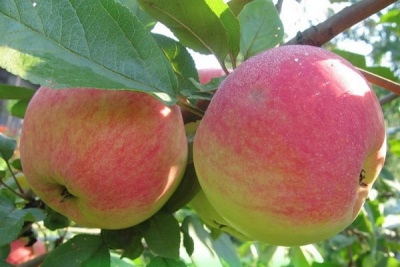
- Taste: sweet, no sour taste
- Scent: there is
- Fruit weight, g: 85-90
- Frequency of fruiting: in a year
- The beginning of fruiting varieties: for 3-4 years
- Ripening terms: summer
- Appointment: cooking compotes, making jam
- Growing regions: Northwestern part of Russia
- Name synonyms: Sweet Avenurius
- Self-fertility: self-infertile
Every gardener, especially without experience, dreams of unpretentious apple trees growing in his garden, which give a high yield. The list of such trees, delighting with tasty and fragrant fruits, includes the summer variety Avenarius.
Breeding history of the variety
This apple variety has a very interesting history, since it was not bred by breeders of some institute, but by a priest who served in a church in the Leningrad region. It was in the name of the priest that the new summer apple variety was named. The variety has another name - sweet Avenurius.
Description of the variety
The Avenarius apple tree is quite tall, as it grows up to 5-6 m, with powerful branches and a developed root system. It has a lush crown several meters wide, so it will require a lot of space in the garden to grow it. During flowering, the crown is covered with white-pink flowers, emitting a pleasant fragrance.
The Avenarius apple tree is of three categories: vigorous (5-6 m high), semi-dwarf (3-4 m high) and dwarf (up to 1 meter high).
Features, pros and cons
Each variety has its own characteristics and Avenarius is no exception. Among the features of this type, it is worth highlighting its winter hardiness, the ability to grow and develop in infertile soils, immunity to diseases and pest infestations, as well as excellent taste.
The disadvantages of a fruit crop include unstable fruiting (some farmers argue that the tree yields a harvest in a year, and not annually), as well as poor self-pollination, suggesting growing near pollinating trees. In addition, the fruit has a short shelf life.
Ripening and fruiting
The apple tree blooms in the third decade of May, when the air temperature reaches 20-25 degrees, and lasts up to two weeks. From the middle of summer, the fruiting period begins. Apples ripen evenly, making harvesting easy. The terms of ripening and fruiting can be influenced by the climatic conditions of the region. The tree bears fruit for 3-4 years of growth and development.
Growing regions
The optimal cultivation area for the variety is a region with moderate climatic conditions, however, due to frost resistance, the seedlings take root almost all around. The apple tree grows on the territory of the Russian Federation, Belarus, Ukraine. More careful care will be required for a tree growing in the northern regions.
Yield
Harvesting begins when the fruit is fully ripe on the tree. A sign of full ripeness is the appearance of a slight blush on the sides of the apples. On average, the time for a bountiful harvest is in the second half of the summer. From an adult apple tree, you can collect up to 30 kg of fruits.
Fruits and their taste
The fruits are characterized by a round shape and small size - 85-90 grams. The apples are very sweet to taste, without sourness, with firm pulp and moderate juiciness. A ripe apple has a pale yellow skin of medium density with a glossy finish that shows a yellow-red blush. The aroma of the variety is pronounced, persistent, fruity.

Growing features
For planting and growing an apple tree, preliminary preparation of the site will be required. For this, an area with good sunlight and no drafts is selected, which is carefully dug up, freed from weeds and other debris. Sod-carbonate, loamy and sod-slightly podzolic soils are considered ideal for cultivating the Avenarius apple tree. The soil should not be swampy and clayey.
Planting seedlings is possible both in autumn and spring. In the spring, the seedling is planted before bud break and when the soil is fully warmed up, and in the fall - a month before frost, so that the root system has time to adapt.



Pollination
This variety belongs to the class of self-fertile, therefore it is recommended to grow pollinating apple trees on the site, which will bloom and bear fruit during the flowering and fruiting period of Avenarius.
Top dressing
For normal growth and development of the tree, top dressing will be required. It is recommended to carry out top dressing at 3-4 years of tree growth. Organic fertilization is applied several times a year. Along with top dressing, you will need watering and pruning of dried branches, the formation of a crown.

Frost resistance
The tree is resistant to low temperatures, however, in regions with severe frosts, additional insulation of the apple tree will be required. As a rule, soil mulching is performed using dry leaves, coniferous branches.

Diseases and pests
The apple tree has good immunity to various kinds of diseases and pest infestations, however, as a preventive measure, spraying with special solutions can be performed.

The apple tree is a popular fruit crop among gardeners. It can be found in many summer cottages. But at the same time, such trees are often affected by various diseases. It is very important to recognize the disease in time and carry out the necessary procedures for a speedy recovery. Otherwise, the fruits will be spoiled, and the tree itself may die altogether.

Review overview
Based on numerous reviews, this variety is ideal for growing in the garden with the aim of obtaining sweet and juicy fruits, but for commercial purposes it is not suitable due to its short shelf life. The variety is considered completely non-capricious, but for beginner gardeners it can be difficult to care for and grow.











































































